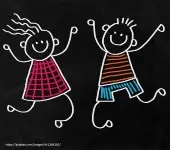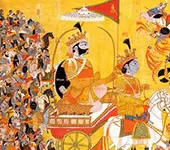This discourse which is part of Mahabharata series tells you about- 1. What is niyoga? 2. Why Vyasa agreed for niyoga?
Were the Kauravas Asuras?
The Pandavas were incarnations of Devas. After Gandharvas defeated Duryodhana and he decided to fast until death, the Asuras took him to Pathala. They told Duryodhana that his upper body was Shiva and his lower body was Parvathy. They got Duryodhana by doing tapas. Many Asuras had already possessed important Kauravas including Bhishma, Drona, and Kripa. The Asuras were controlling them. Narakasura's soul had possessed Karna. Using the bodies of the Kauravas, in fact, the Asuras were fighting Lord Krishna and the Devas who had taken birth as Pandavas. (Vana Parva,252)
Niyoga rules
If the husband is impotent or dies childless, the wife can conceive from a brother-in-law. This is called niyoga and is allowed only in the case of childlessness. A woman can do niyoga only for one child or a maximum of two. After the successful union, if the brother-in-law is younger, he treats the woman as his mother. If he is elder, he treats her as his daughter-in-law. Niyoga should be at night. The man has to wear white clothes and apply ghee all over his body for purity. The man and woman have to keep their mind pure and be clear that the act is only for begetting a child. If a prospective bridegroom dies after the engagement, the woman can go for niyoga. (Manu Smriti.9)
Quiz
After Vyasa Maharashi divided Vedas into four, whom did he teach Yajurveda first ?Transcript
(Click here to read more)
Ugrashrava Sauti says: Mahabharata, compared by him to a gigantic tree, has got flowers and fruits that are eternal. The blossomed flowers of Bharata is dharma and its fruits is moksha. The most visible attractive part of a tree or plant is its flowers. Dharma is the most visible aspect of Mahabharata. And what the tree passes on, what you can get from a tree is fruits, that is the benefit and Mahabharata’s fruits is attainment of moksha. By reading Mahabharata, listening to Mahabharata, by understandi....
Transcript
(Click here)
Ugrashrava Sauti says:
Mahabharata, compared by him to a gigantic tree, has got flowers and fruits that are eternal.
The blossomed flowers of Bharata is dharma and its fruits is moksha.
The most visible attractive part of a tree or plant is its flowers.
Dharma is the most visible aspect of Mahabharata.
And what the tree passes on, what you can get from a tree is fruits, that is the benefit and Mahabharata’s fruits is attainment of moksha.
By reading Mahabharata, listening to Mahabharata, by understanding Mahabharatha, the benefit is the attainment of moksha.
Vyasa is dharma.
He is dharma embodied.
Whatever he has done is for the upkeep of dharma.
He has never flouted dharma.
Vichitravirya was Vyasa Maharshi’s half-brother.
Common mother- Satyavati.
Vyasa’s father was Sage Parashara.
Vichitravirya’s father was King Shantanu.
After Vichitravirya passed away, as per the instruction of Satyavati and Bhishmacharya, Vyasa caused birth of three children- one through Ambika, one through Ambalika, and one through a maid.
Ambika and Ambalika were his half-brother’s wives who was no more.
Is this dharma?
Women conceiving through their brother-in-law.
How can this be dharma?
And mind you, this is how the most celebrated scripture on dharma starts.
That means our understanding of what is dharmik and what is not dharmik could be incomplete and immature.
We look at things through our own eyes as we have seen the world for a few decades.
This is not correct.
We should not be doing this.
The subject is so vast, we can’t be passing judgment with our limited exposure and knowledge.
There was a king called Vena.
A very wicked and evil king.
Rishis killed him with mantra vidya.
He didn’t have a successor.
The same Rishis churned his body and produced a child.
That was Raja Prithu who became very famous as a dharmishta.
So, Rishis churned the dead body of an adharmik person and produced a dharmik person out of it.
Are we capable of pronouncing judgement?
That this was right, this was not right.
Forget passing comments.
Don't use your limited brain to analyze.
Just understand how it all works.
Dharma is eternal.
One simple reason why Vyasa did this.
This may not be the only reason.
Vichitravirya died without giving birth to a successor.
His elder brother Chitrangada also died without a child.
They were the successors of Shantanu and died childless.
Bhishma had already taken a vow of celibacy and he wouldn’t break it.
The kingdom needs a King.
Or else, who will protect its people?
Who will administer it?
Vyasa did not do this for enjoyment.
He was following an instruction.
Vyasa didn’t take over as the King or stay on to enjoy the comforts of a royal life.
As soon as he did what he was told to do, he went back to his ashrama.
The need was for a successor king for the welfare of the kingdom and what Vyasa did was what dharma says, what shastra says what one should do under such circumstances.
This is what Mahabharatha would do, as you read on or listen it would change your whole perspective.
Three sons were born- Dhritarashtra, Pandu, and Vidura.
Vidura was the maid’s son.
All three were as brilliant as Agni.
So remove that picture of Dhritarashtra from your mind with that cunning look and black clothes.
Bharatha says he was as brilliant as Agni, at least when he was born.
Vyasa Maharshi released Mahabharata on earth after the demise of these three; Dhritarashtra, Pandu, and Vidura.
अब्रवीत् भारतं लोके मानुषेऽस्मिन्- this is as far as its release in Manushya Loka is concerned.
This has to be clear.
Where did this release happen?
When Janamejaya and thousands of others asked.
The venue was Sarpa Yajna.
As and when there were breaks in the yajna procedures, they would all gather and they were eager to listen.
Then Vyasa Maharshi told his disciple Vaisampayana who was with him that you narrate Mahabharata to these people.
Sauti is telling this.
That means Vaishamapayana had already heard this before from his Guru Vyasa Maharshi and he was going to narrate to Janamejaya and others who had gathered at the venue of Sarpa yajna.
Recommended for you
Vastu tips for your business place
 Click here to know more..
Click here to know more..
Perseverance supersedes physical handicaps

Perseverance supersedes physical handicaps....
Click here to know more..Ganesha Aparadha Kshamapana Stotram

kri'taa naiva poojaa mayaa bhaktyabhaavaat prabho mandiram naiva dri'sht'am tavaikam| kshamaasheela kaarunyapoorna praseeda samastaaparaadham kshamas....
Click here to know more..
English Topics
Mahabharatam
Click on any topic to open
- 95 What is behind Calling the Five Brothers the Pandavas
- 94 Give up an Individual IF....
- 93 Fascinating Birth Story of the Kauravas
- 92 Overcoming Grief - Lessons from King Senajit's story
- 91 Yayati's Wisdom
- 90 Yayati's Story
- 89 Brahmacharis Can Bless And Curse
- 88 Human Nature - Comples Mix Of Good And Bad
- 87 Results Of Good Karma
- 86 What Gives Results - Luck or Effort?
Please wait while the audio list loads..
30
Ganapathy
Shiva
Hanuman
Devi
Vishnu Sahasranama
Mahabharatam
Practical Wisdom
Yoga Vasishta
Vedas
Rituals
Rare Topics
Devi Mahatmyam
Glory of Venkatesha
Shani Mahatmya
Story of Sri Yantra
Rudram Explained
Atharva Sheersha
Sri Suktam
Kathopanishad
Ramayana
Mystique
Mantra Shastra
Bharat Matha
Bhagavatam
Astrology
Temples
Spiritual books
Purana Stories
Festivals
Sages and Saints
